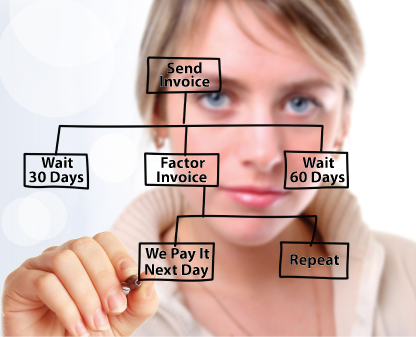
On the other hand, invoice factoring can provide you with cash resources as fast as the same day!ģ. The application process for a bank loan can take up to a few months. Faster Turnaround Time as Compared to Taking Up a Loan Additionally, if your business has sufficient capital, you can take up new jobs without relying on payment of previously fulfilled orders, increasing your potential earnings.Ģ. Most factoring companies pay a percentage of the invoice's value before the customer pays so you instantly get some cash upfront. It does not involve incurring debt, and it is easier to qualify for than a bank loan. When you sell outstanding invoices to a factoring company, they only deduct the fee from the value of the invoice in the form of commission or interest. Cottonbro / Pexels Benefits of Invoice Factoring 1. Due to expensive fees, this method is uncommonly used unless a business urgently needs cash.Ĭan't afford to earn less with invoice factoring? We share 9 must-have invoice traits that ensure that your clients have the information they need to pay you on time.įactoring companies can support your business with credit control management. With the most flexibility but the highest commission rate, spot factoring allows you to factor a single invoice or load. Businesses that employ this method must have a credit control process for the invoices they decide to handle on their own. This flexibility usually means a higher commission rate than whole-turnover, but a lower price than spot factoring. Selective factoring (also known as partial debt financing) grants your business the flexibility to choose which invoices to factor and is useful when you can identify customers who regularly pay on time to save on unnecessary factoring costs. It can rely on the factoring company's established procedures and professionalism in the collection of accounts receivable. This approach is useful when the firm does not have a credit control process. A contract of at least 12 months typically is signed between the business and the factoring company. In whole-turnover factoring, all invoices issued to customers are given to the factoring company for collection. Due to the more significant risk and amount of time and resources spent, the company charges a higher commission rate or fee. Only in certain situations (such as the customer refusing to pay due to faulty goods) can the factoring company claw back the advance given.Īs they are taking on higher risk, it is typical for the factoring organization to do thorough background checks on your company and your customers. If the customer fails to make the payment, you must return the advance to the factoring company.įor non-recourse factoring, the factoring company takes on the liability of bad debt if the customer defaults on payment. Recourse factoring is the most common practice for factoring companies as it protects them from losing money if your customer does not pay up. In recourse factoring, it is your business's responsibility to bear the outstanding amount if your customer defaults on their debt. The number of invoices a business decides to sell to the factoring company.


Factoring companies earn profit by charging a portion of your invoice value as a service fee. The ideal scenario is for your cash inflows to be more than your cash outflows.īy selling outstanding invoices to an invoice factoring company, you can increase positive cash flow and direct it to finance other aspects of your business.Ĭurious to learn more about cash flow statements? Check out our cash flow guide here. How does Invoice Factoring Improve My Cash Flow?Ĭash flow management is an integral part of sustaining your business. Check out our tips on invoicing in our comprehensive invoice guide here. Improving your invoice layout is an easy way to reduce the chances of delayed payment. Some businesses miss out on crucial information in their invoices, resulting in late payment. Although utilizing invoice factoring results in a lower profit-margin, you get to enjoy a stable cash flow. These factoring businesses pay a percentage of the value of these invoices and rebates the rest (after deducting fees) once your customer has paid. Invoice factoring is a financing method for businesses where unpaid invoices are sold to factoring businesses. Karolina Grabowska / Pexels What is Invoice Factoring? Invoice factoring can be used to boost your business cash flow when too much cash is tied up in your accounts receivable. Frustrated with late payments from customers? Invoice factoring is a viable alternative to improve your business cash flow.Īre you facing cash flow problems with too much cash tied up in accounts receivables? Invoice factoring can tide you over by providing you an advance on your unpaid invoices.


 0 kommentar(er)
0 kommentar(er)
